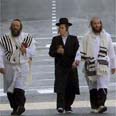
Sephardic ultra-Orthodox residents banned (Illustration photo)
צילום: רויטרס
Sephardim? Not in this neighborhood
Reception committee at ultra-Orthodox town decides to ban additional families of Middle Eastern descent from entering some of its streets, buildings in order to 'maintain community's high spiritual level'
Meet Rav and Shmuel Street in the ultra-Orthodox town of Kiryat Sefer in central Israel: A corner street, a great view, and lots of children with side curls playing around. But there is something else this street has: It is the only street in Israel where Jews of Middle Eastern descent are not allowed to move to.
The Brachfeld neighborhood's reception committee decided to ban additional Sephardic families from entering streets and buildings in which 35 percent of the tenants are Sephardic.
In order to live in the Barchfeld neighborhood, yeshiva student's prestigious neighborhood, one must be inspected by the neighborhood's reception committee. In addition, the children of people who sell or buy an apartment without the committee's approval will not be able to register to the local school.
The candidates who arrive at the committee are required to meet demands of modesty, personality, religious background, and more. Television is obviously prohibited and internet is considered serious obstacle in the eyes of the committee. In addition, the apartment can only be sold with an approval of the reception committee.
The reception committee is aimed at "maintaining a high spiritual level at the community" and preventing unwanted ultra-Orthodox elements from infiltrating the place.
The reception committee recently decided that there are too many residents of Middle Eastern descent in some of Brachfeld's streets and buildings. Therefore, Sephardic Jews wishing to live in the town cannot live on Rav and Shmuel Street and are directed to other streets.
'It's not that we are racist'
In the other streets, however, they also encounter difficulties, as there are buildings there in which 35 percent of the tenants are already Sephardic and are thus closed to additional Sephardim.
"The rate of people becoming newly religious is higher among the Sephardim, and the spiritual risk in letting such families enter the neighborhood is higher," a top go-getter at Kiryat Sefer said.
"It's not that we are racist, but we worry for our children's future. This scattering is also in favor of the Spehardim," he added.
It should be mentioned that newly religious Jews of East European or Western origin are considered problematic by the ultra-Orthodox community as they sometimes bring with them behaviors from their secular past, such as watching television.
"I am trying to sell my apartment, and if a Sephardic client comes along, I'll have a problem because I'll be surpassing the percentage in my building," one of Brachfeld's residents said.
"It's an economic issue. People don’t want Sephardim to live in the neighborhood, because then Ashkenazim will not buy apartments and the value of the apartments will decrease," the resident added.
The Kiryat Sefer Council said in response: "The council does not populate and market apartments but only provides its residents with services. The marketing and populating activities are performed by private elements. The council has nothing to do, and never had anything to do, with the different populating committees."










